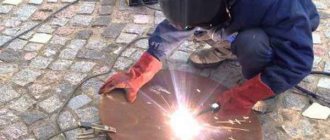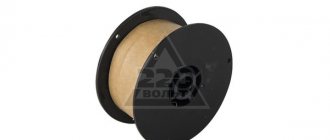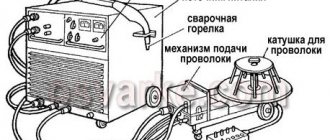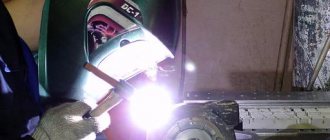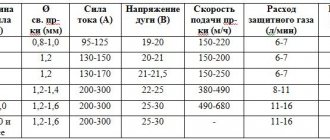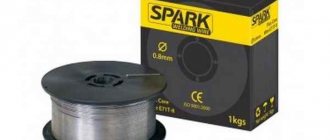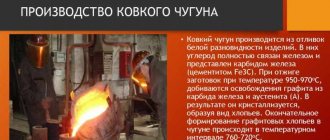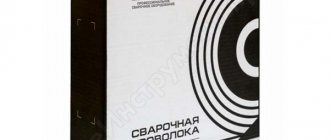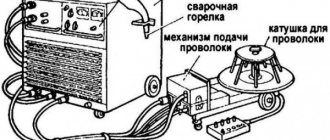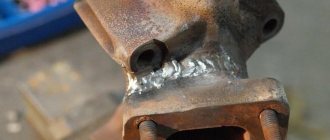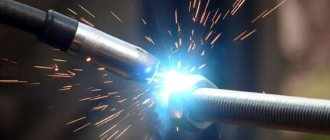Aluminum welding wire is a filler material for producing permanent joints from the corresponding metal. Joining aluminum, as well as alloys based on it, is a labor-intensive process that requires good skills and attention from the master in his work. The technology for using this electrode material involves the use of a protective gas, which is usually argon. Provided that the parameters are properly adjusted, the welding seam will be very reliable, not inferior in its characteristics to a monolithic surface.
The difficulty of working with aluminum is due to the presence of a refractory oxide film on the surface, while the metal itself has a low melting point.
Types and rules of application
This product is divided into two main categories, according to the area of application:
- For cold heading work . Products are manufactured in compliance with the requirements of interstate GOST standards. In addition, this wire is used in the production of cables and wires, grounding systems, as well as for metallization of various surfaces.
- For welding work , as an electrode material.
Generally, aluminum wire has a round cross-section, however, some industries require a product with a rectangular or round cross-section. It is widely used in electrical production.
The last category is the most common. It differs in the type of delivery, depending on the connection technology:
- In rods up to 1000 mm long . Designed for argon arc welding in a shielding gas environment. Package weight is 5-10 kg.
- In international cassettes . Used for welding in semi-automatic mode. The diameter of the drum and the cross-sectional area depend on the characteristics of the welding equipment and the type of surface being joined.
Flux-cored wire deserves special attention. Its main feature is the ability to make connections without shielding gas . The special powder is a flux material that protects the joint area from contact with atmospheric air.
To join aluminum-based alloys, we recommend choosing a universal filler material. A competent choice of electrode wire allows you to obtain a high-quality and reliable seam with the following qualities:
- no cracks;
- strength;
- plastic;
- corrosion resistance.
Correct selection of consumables and setting up the operation of welding equipment is half the battle . The second part consists of preparatory work, during which it is necessary to remove the oxide film.
Important! The interval between preparation and welding should be minimal - the process of formation of a new film proceeds very quickly.
The original packaging protects the wire from reaction with oxygen, so it is recommended to open it immediately before use to avoid oxidation.
To join aluminum alloys, various elements are added to the wire composition to improve the quality characteristics of the seam. Additional components include manganese, silicon, magnesium and other chemical elements.
Flaws
- Both the base material itself and the wire to it are covered with an oxide film, which requires processing before the joining process, otherwise the level of quality will drop;
- Due to the large assortment, it is sometimes difficult to choose the most suitable wire model, especially since it is not always known what alloy you have to work with;
- It is imperative to use an inert shielding gas, which makes the cost of welding quite high and difficult to implement at home;
- Precise adjustment of feed parameters is required due to the high melting rate of the wire material.
Physicochemical characteristics
The chemical properties of wire are largely determined by its composition. Taking into account the fact that aluminum is one of the fundamental metals that welding wire SV06X14, as well as other grades, contains, it receives most of its properties from it. The material interacts poorly with other metals, so inclusions of alloying elements here are minimal. High susceptibility to oxides remains, which requires pre-treatment with solvents. At the same time, the seam retains high corrosion resistance even after heat treatment.
Welding wire 18ХМА
In addition, welding wire 18ХМА has high ductility and a low melting point. This helps to work with metal without exposing it to high temperatures. When heated, the consumable material does not change color, which slightly complicates visual control, but when working with a semi-automatic device, everything will depend only on the correct mode. It is also worth noting that the wire does not spoil the electrical conductivity of aluminum, which turns out to be higher than that of copper, therefore, it is also used in the repair of electrical appliances.
Specifications
| Wire grade | Compound | What is it used for? |
| SV A99 | Pure aluminum (99%) | For welding pure aluminum, which has a minimal proportion of impurities. |
| SV A85T | Aluminum – 85% Titanium – 1% | For welding pure aluminum, which has a minimal proportion of impurities. |
| SV AMg3 | Aluminum Magnesium – 3% | For welding aluminum-magnesium alloys with a predominance of aluminum. |
| SV AMg63 | Aluminum Magnesium – 63% | For welding aluminum-magnesium alloys with a predominance of magnesium. |
| SV AK5 | Aluminum Silicon – 5% | For welding aluminum-silicon alloys with a predominance of aluminum. |
| SV AK10 | Aluminum Silicon – 10% | For welding aluminum-silicon alloys with a predominance of aluminum. |
| SV 1201 | Aluminum Copper | For welding aluminum-copper alloys with a predominance of aluminum. |
Features of choice
When selecting a filler material for a semi-automatic machine, you should first decide on what metal the welding will take place with. This is one of the most important points, since the composition of the base and filler materials should be as similar as possible.
"Important!
If the exact composition of the product that needs to be welded is unknown, then a neutral option is selected, which can be welding wire SV 08GA.”
The second parameter is the thickness that will have to be encountered. Here everything is as simple as possible, since the greater the thickness of the workpiece being welded, the thicker the wire should be. For aluminum, which melts quite quickly, you need to carefully select modes so as not to spoil the base metal. Due to difficulties in weldability, gas welding and argon arc welding are used even with large thicknesses, but this may require cutting the edges.
Scheme of gas welding of aluminum
Many manufacturers produce wire in coils of various sizes. Long-term monotonous work requires a large supply of material, so it is more profitable to buy coils with a maximum wire length. For the private sphere there is no such need, therefore, you can stick to simpler options.
Aluminum wire for semi-automatic machine
When choosing, you need to pay attention that the consumable material and the base metal have approximately the same melting point. Due to additional elements in the alloy, the values can reach critical values, so that the seam either cannot create a normal strong connection, or the base metal will burn out, and the wire will not reach the desired state for welding.
Features of welding aluminum with semi-automatic wire
When using 09G2S welding wire or another brand, it is necessary to take into account the increased tendency of the metal to warp, since it has a large linear expansion coefficient. The metal itself and the wire made from it have low elasticity, which leads to deformation. When working on a semi-automatic machine, it is necessary to firmly fix the parts using an additional weight, a press or other available methods
Before each start of the welding process, it is imperative to carry out chemical cleaning to remove oxides and other negative accumulations on the surface. Protection must be provided during welding itself. Even when working semi-automatically, there is a high probability of cracks appearing due to temperature changes and oxygen and hydrogen entering the seam. All of the above procedures help reduce this risk.
Physicochemical characteristics
Aluminum is a silvery-white metal that occurs in nature only in compounds with other chemical elements . In its pure form, it is obtained by electrolysis of dissolved alumina obtained from bauxite.
This metal has a relatively low density. Its melting point is 658 Cº. Possessing a high affinity for oxygen, due to which it is capable of reducing most metals from oxides.
When interacting with atmospheric air, the metal is quickly covered with a film that protects it from further interaction with the environment. The oxide film provides high stability when interacting with a humid environment, nitric acid, and most acids of organic origin.
Equipment selection and configuration
Semiautomatic welding machine for aluminum
Welding of aluminum with standard MIG machines is conditional, i.e. You can cook with it, but you shouldn’t expect good results.
The optimal solution in choosing is a semi-automatic aluminum welding machine with a pulse mode. The pulses penetrate the oxide film, reduce overheating of aluminum and reduce the likelihood of burnout.
Pulsed welding of aluminum with direct current
Synergetic pulse-arc devices, equipped with a special program, make the task even easier. The welder needs to decide on the choice of alloys to be welded and select the appropriate program. Next, set the current value using the push-button regulator. The selection of other parameters is carried out automatically by the microcontroller.
I would like to note that these semi-automatic devices are not a cheap pleasure and are justified in professional use. At home, it is quite possible to get by with the equipment without fancy programs, however, the quality of the welding seam will not be comparable.
When purchasing a universal semi-automatic welding machine in a price range of up to 40 TR, designed for welding non-ferrous metals, incl. aluminum, you can take a closer look at the following models:
- Svarog REAL MIG 200 (N24002)
- Svarog PRO MIG 160 SYNERGY (N227)
- Svarog PRO MIG 200 SYNERGY (N229)
- Grovers MULTIMIG 200 SYN
- Aurora PRO OVERMAN 180
Wire for semi-automatic machine
When welding aluminum semi-automatically, certain requirements are imposed when choosing a welding wire
Important points to pay attention to:
- The melting temperature of the wire must be comparable to the temperature of the metal being welded. Less scatter – the welding process is easier;
- optimal wire diameter 1.2-1.6 mm;
- larger diameter means easier feeding into the welding zone.
Common types of aluminum welding wire are ER4043 and ER5356. Designed for welding and repairing products made of aluminum and its alloys with a silicon content of no more than 5%.
Welding modes for ER4043 and ER5356 wires
| Wire diameter, mm | Voltage, V | Current, A | Gas consumption, l/min |
| 0,8 | 13-24 | 60-170 | 15 |
| 0,9 | 13-24 | 60-170 | 15 |
| 1,0 | 15-26 | 90-210 | 16 |
| 1,2 | 20-29 | 140-260 | 19 |
| 1,6 | 25-30 | 190-350 | 25 |
Aluminum welding wire ER 4043
Welding torch
The welding torch adopts Teflon guide to reduce wire friction. It is advisable that the hose for welding aluminum is intended only for welding aluminum and is not too long - 3 m is just right.
Push-pull burner
The contact tip must be designed for welding aluminum (in addition to the wire diameter, the AL marking is stamped on them); simple ones used for welding ferrous metals and stainless steel are not suitable. This is due to the strong expansion of aluminum during heating. The diameter of the hole should be approximately 0.4 mm larger than the diameter of the wire, and at the same time not too large, in order to ensure good electrical contact.
It is difficult to use aluminum wire with a diameter of 0.8 mm due to the plasticity of the metal and the difficulty of drawing. The solution to this problem can be the use of a Push Pull welding torch. A special built-in mechanism will improve wire feeding and increase the length of the torch.
Wire feeder
Due to the increased ductility and softness of aluminum wire compared to steel, the feeding mechanism must have a number of features, such as:
- four-roller feeder. Necessary for uniform pressure on each pair of rollers;
- Feed rollers with U-shaped grooves, designed specifically for working with aluminum wire.
Shielding gas
Argon is most often used as a shielding gas, which has a good cleaning effect and good penetration into the weld pool. When welding aluminum alloys with a high magnesium content, mixtures of argon and helium (up to 75% helium in the mixture) are used as a shielding gas. Such mixtures prevent the formation of magnesium oxides.
Here the question may arise: how to cook aluminum in a carbon dioxide environment or without gas at all, since argon is quite expensive?
Cheaper carbon dioxide, used for welding low-carbon steels, is not suitable in this case. CO2 is an active gas, it will protect the weld pool from air, but at the same time it will react with aluminum, preventing the formation of a strong connection. Therefore, in this case, it is inert gas that is used.
Semi-automatic welding without gas is possible using a special flux-cored wire that protects the weld pool.
Specifications
Welding wire for aluminum has the following qualities:
- low weight;
- strength;
- flexibility;
- moisture resistance;
- fusibility;
- resistance to aggressive environments;
- low magnetic qualities;
- long storage period provided the packaging is intact;
- low biological activity;
- high thermal and electrical conductivity.
According to the requirements of the interstate standard, aluminum wire for a semi-automatic machine may have the following designations:
- AM – soft.
- ATP – semi-solid.
- AT – hard.
- ATp - increased strength.
Compatibility of welding wire with devices
Today you can find several types of reference devices. First of all, they differ in the source of the welding current, or the type of shielding gas used. Each type of wire requires voltage, temperature and flame density corresponding to its composition.
In domestic use, the most common types of welding are consumable electrode welding, manual gas welding, and those involving the use of a semi-automatic installation. The last position is the most popular. Therefore, it is easiest to buy welding wire for a semi-automatic machine. As a rule, in such cases it is recommended to use a universal, general-purpose material.
A semi-automatic welding device allows you to achieve optimal work results, subject to proper operation. As a rule, such devices find their use in small industries, frequent construction, vehicle repair and household use. The availability of technology and consumables has made this type of device the most popular in the welding equipment market.
Features of choice
When welding parts made of aluminum alloys, the correct choice of electrode wire is especially important - this is the key to obtaining a durable connection . Each alloy has its own type of wire, recommended by consumables manufacturers as optimal. For example, for welding deformable alloys AMg3, AMg4, AMg5, it is recommended to use the appropriate wire - ER 5336, which has the following characteristics:
- base – aluminum;
- maximum strength – 120 MPa;
- maximum strength – 265 MPa;
- elongation – 26%;
Mass fraction of additional elements:
- Mg – 4.9;
- Mn – 0.15;
- Fe – <0.2;
- Si – <0.15.
Domestic wire AMg5 has similar properties.
In addition to specialized ones, manufacturers offer universal compounds capable of welding most alloys.
Retail prices for aluminum wire
| Brand according to AWS (GOST) | Diameter, mm | Packaging, kg/pack | PRICE, rub./kg. VAT included |
| MIG ER-4043 (AlSi5) Sv-AK5 | 0,8 | 0.5 (D100) | 1274,8 |
| 0,8 | 2.0 (D200) | 1167,9 | |
| 0,8 | 6.0 (D300 | 1129,8 | |
| 1,0 | 0.5 (D100) | 984,6 | |
| 1,0 | 2.0 (D200) | 885,6 | |
| 1,0 | 7.0 (D270) | 847,4 | |
| 1,2 | 6.0 (D300) | — | |
| 1,2 | 7.0 (D270) | 822,5 | |
| 1,6 | 7.0 (D300) | 812,8 | |
| MIG ER-5183 (AlMg4.5Mn) | 1,2 | 7.0 (D300) | 925,0 |
| MIG ER-5356 (AlMg5) Sv-AMg5 | 0,8 | 2.0 (D200) | 1009,4 |
| 0,8 | 0.5 (D100) | 1111,8 | |
| 0,8 | 6.0 (D300) | 971,2 | |
| 1,0 | 0.5 (D100) | 984,6 | |
| 1,0 | 2.0 (D200) | 885,6 | |
| 1,0 | 7.0 (D270) | 847,4 | |
| 1,2 | 2.0 (D200) | 875,3 | |
| 1,2 | 7.0 (D270) | 822,5 | |
| 1,6 | 7.0 (D300) | 812,8 |
You can buy aluminum wire at retail in our online store. Check with the manager for wholesale prices
Features of welding aluminum with semi-automatic wire
When working with this metal, it is necessary to carefully monitor the stability of the arc, the length of which should be within 12-15 mm. Shortening the length is guaranteed to result in burnout. A long arc is not capable of fusing parts properly. The correct size depends on several factors:
- Thickness of connected elements;
- Chemical composition of the alloy;
- Thermal conductivity.
The greatest difficulty lies in welding the crater at the end of the work . This is due to the fact that aluminum crystallizes very quickly. Only experience will help you successfully solve this problem, although using a four-stroke torch will make the work much easier, thanks to welding at low current at the final stage.
How to make the right choice?
Flux-cored wire and other analogues must be selected carefully; if you find it difficult to choose, the managers of our company will guide you and select the product in accordance with your budget. Only in this case can you be sure that the welding will not be characterized by a high level of slagging; you are also guaranteed to avoid cracks and cavities in the weld. Welding wire can be supplied in different diameters; this parameter, in turn, affects the thickness of the metal being welded. Let us add that the thickness of the consumable material is also determined by the capabilities of the device. Some models are only designed to work with a thickness of 0.6 mm, while powerful ones can melt rods with a thickness of 1 mm or more. Based on the volume of work, you should decide on the number of electrodes for welding; you can buy coils weighing up to 15 kg from our company.
Features of feeding mechanisms
Classic wire feeding mechanisms do not cope well with plastic materials.
For soft metal, it is recommended to use a four-roller system , since they do not deform the wire during feeding.
The length of the supply hose should not exceed 3 meters. Otherwise the wire will not reach the burner.
The diameter of the tip hole should be 2 mm larger than the cross-section of the aluminum wire, since the electrode metal expands when exposed to temperature.
When using a Teflon hose, the working length can be increased by 50% due to the lower coefficient of friction.
Designation and markings
GOST 7871-75 defines the designation and marking of welding wire made of aluminum and its alloys. Let's look at examples: Wire V.St. AMg5. M. 4.00xBT GOST 7871-75 and Wire P.St. AMts. N. 5.00xBR GOST 7871-75.
- The signs “B” and “P” reflect the technological methods for manufacturing wire. It can be drawn “B” or pressed “P”. The drawn one is made by drawing through a die (calibrated hole), the pressed one is formed in the matrix by the force of the press.
Aluminum wire AL Mg 5 Foxweld. Photo VseInstruments.ru
- St. AMg5, St. AMts - gives the characteristics of the aluminum alloy from which the wire is made.
- For the most part, this consumable material is supplied in cold-hardened form (“N”). However, some customers use wire in the annealed state (“M”).
- 4.00; 5.00 – wire diameters in mm.
- BT – supplied in coils, BR – in coils.
Foreign manufacturers designate products according to the AWS (American Welding Society) standard. ER 4043 according to the AWS standard corresponds to AK5 grade welding wire.
Safety precautions
The use of protective equipment is a necessary condition for welding work. It is mandatory to use a respiratory respirator, a protective mask, special clothing and shoes to protect against the glow of the welding arc and splashes of molten metal. The acrid white smoke released when welding aluminum causes coughing and headaches.
Particular attention should be paid to protecting exposed areas of the body from the influence of UV radiation, because when welding aluminum it is much more intense than when welding other metals
When you try to weld in “shorts” and in a “T-shirt”, you will get the solarium effect after 30 minutes.
Semi-automatic welding of aluminum is not comparable in quality to using TIG, but it is more than compensated for by significant productivity. It is an excellent solution for surfacing or filling large gaps. In industrial production conditions, the use of semi-automatic machines is most appropriate due to the volume and high speed requirements. The use of industrial equipment and highly qualified welders allow us to achieve excellent results.
Types of electrode wire. Their operating principle
Depending on the semi-automatic welding method, the wire can be used:
- In a protective gas environment.
Welding can be carried out using inert (without carbon dioxide) and active (with carbon dioxide) gases. According to GOST No2246-70, with this technology 75 grades of wire can be used, which can be used to connect almost all metals. Semi-automatic welding of cast iron, zirconium, aluminum, magnesium, titanium, etc. is especially popular.
semi-automatic welding in a protective gas environment
Wire melting occurs with the help of an arc that is formed between the electrode and the metal part. During this, the weld pool is filled with gases, which displace air, which deteriorates the quality of the weld. To prevent pores from forming in the welding seam, the shielding gas pressure should be 0.6 - 0.8 MPa. For stable arc burning and low energy consumption, filler wire with a diameter of 0.5 - 3 mm is used.
- Without using gas (FLUX).
semi-automatic welding with flux-cored wire without gas
Flux-cored, also self-protecting, wire for semi-automatic is useful for mounting large structures, especially if the parts being welded are difficult to reach. Fluxed wire is needed when joining non-ferrous metals, their alloys, low-carbon steel, and steel with any degree of alloying. The most common consumable diameters are 2 mm, 5 mm and 8 mm.
Flux-cored welding wire for semi-automatic machines melts under the influence of the welding arc. At the same time, the metal surface melts. The depth of penetration depends on the thickness of the wire and the applied current. A weld pool is formed, covered with a thin layer of slag. Once the arc is removed, the molten material crystallizes to form a seam joint, and the remaining slag can be cleaned out. It is important that the flux-cored wire contains as few chemicals as possible that release toxins when reaching high temperatures.
